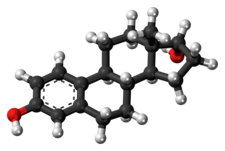
Minoxidil is a medication used for the treatment of high blood pressure and pattern hair loss. It is an antihypertensive vasodilator. It is available as a generic medication by prescription in oral tablet form and over the counter as a topical liquid or foam.

Dihydrotestosterone is an endogenous androgen sex steroid and hormone primarily involved in the growth and repair of the prostate, the production of sebum, and body hair composition.

Finasteride, sold under the brand names Proscar and Propecia among others, is a medication used to treat pattern hair loss and benign prostatic hyperplasia (BPH) in men. It can also be used to treat excessive hair growth in women. It is usually taken orally but there are topical formulations for patients with hair loss, designed to minimize systemic exposure by acting specifically on hair follicles.
The management of hair loss, includes prevention and treatment of alopecia, baldness, and hair thinning, and regrowth of hair.

Oxymetholone, sold under the brand names Anadrol and Anapolon among others, is an androgen and anabolic steroid (AAS) medication which is used primarily in the treatment of anemia. It is also used to treat osteoporosis, HIV/AIDS wasting syndrome, and to promote weight gain and muscle growth in certain situations. It is taken by mouth.

Androstenediol, or 5-androstenediol, also known as androst-5-ene-3β,17β-diol, is an endogenous weak androgen and estrogen steroid hormone and intermediate in the biosynthesis of testosterone from dehydroepiandrosterone (DHEA). It is closely related to androstenedione (androst-4-ene-3,17-dione).

Pattern hair loss (also known as androgenetic alopecia (AGA)) is a hair loss condition that primarily affects the top and front of the scalp. In male-pattern hair loss (MPHL), the hair loss typically presents itself as either a receding front hairline, loss of hair on the crown (vertex) of the scalp, or a combination of both. Female-pattern hair loss (FPHL) typically presents as a diffuse thinning of the hair across the entire scalp.
Non scarring hair loss, also known as noncicatricial alopecia is the loss of hair without any scarring being present. There is typically little inflammation and irritation, but hair loss is significant. This is in contrast to scarring hair loss during which hair follicles are replaced with scar tissue as a result of inflammation. Hair loss may be spread throughout the scalp (diffuse) or at certain spots (focal). The loss may be sudden or gradual with accompanying stress.

3α-Androstanediol also known as 5α-androstane-3α,17β-diol and sometimes shortened in the literature to 3α-diol, is an endogenous steroid hormone and neurosteroid and a metabolite of androgens like dihydrotestosterone (DHT).

Promestriene, also known as estradiol 3-propyl 17β-methyl diether, is a synthetic estrogen which is used topically in a 1% cream formulation for the treatment of vaginal atrophy in women. It is the 3-propyl and 17β-methyl diether of estradiol and does not appear to convert into estradiol in the body. Promestriene is minimally absorbed and appears to have negligible systemic estrogenic effect. The drug has been described as a tropic agent and antiseborrheic. It has not been found to be effective in the treatment of pattern hair loss or other conditions of cutaneous androgenization. Promestriene was first introduced in France in 1974 and has been marketed in 34 countries worldwide. It has been used in millions of women.
The drug combination alfatradiol/dexamethasone is used topically for the treatment of mild to moderate androgenic alopecia in younger women.

3β-Androstanediol, also known as 5α-androstane-3β,17β-diol, and sometimes shortened in the literature to 3β-diol, is an endogenous steroid hormone and a metabolite of androgens like dehydroepiandrosterone (DHEA) and dihydrotestosterone (DHT).

17α-Estradiol is a minor and weak endogenous steroidal estrogen that is related to 17β-estradiol. It is the C17 epimer of estradiol. It has approximately 100-fold lower estrogenic potency than 17β-estradiol. The compound shows preferential affinity for the ERα over the ERβ. Although 17α-estradiol is far weaker than 17β-estradiol as an agonist of the nuclear estrogen receptors, it has been found to bind to and activate the brain-expressed ER-X with a greater potency than that of 17β-estradiol, suggesting that it may be the predominant endogenous ligand for the receptor.

A nonsteroidal antiandrogen (NSAA) is an antiandrogen with a nonsteroidal chemical structure. They are typically selective and full or silent antagonists of the androgen receptor (AR) and act by directly blocking the effects of androgens like testosterone and dihydrotestosterone (DHT). NSAAs are used in the treatment of androgen-dependent conditions in men and women. They are the converse of steroidal antiandrogens (SAAs), which are antiandrogens that are steroids and are structurally related to testosterone.

Topilutamide, known more commonly as fluridil and sold under the brand name Eucapil, is an antiandrogen medication which is used in the treatment of pattern hair loss in men and women. It is used as a topical medication and is applied to the scalp. Topilutamide belongs to a class of molecules known as perfluoroacylamido-arylpropanamides.
A steroidogenesis inhibitor, also known as a steroid biosynthesis inhibitor, is a type of drug which inhibits one or more of the enzymes that are involved in the process of steroidogenesis, the biosynthesis of endogenous steroids and steroid hormones. They may inhibit the production of cholesterol and other sterols, sex steroids such as androgens, estrogens, and progestogens, corticosteroids such as glucocorticoids and mineralocorticoids, and neurosteroids. They are used in the treatment of a variety of medical conditions that depend on endogenous steroids.

17α-Ethynyl-3α-androstanediol, also known as 17α-ethynyl-5α-androstane-3α,17β-diol, is a synthetic androstane steroid and a 17α-substituted derivative of 3α-androstanediol which was never marketed. It was under development for the treatment of prostate cancer but was discontinued.

5α-Dihydroethisterone is an active metabolite of the formerly clinically used but now-discontinued progestin ethisterone and the experimental and never-marketed hormonal antineoplastic agent ethynylandrostanediol (HE-3235). Its formation from its parent drugs is catalyzed by 5α-reductase in tissues that express the enzyme in high amounts like the liver, skin, hair follicles, and prostate gland. 5α-DHET has significant affinity for steroid hormone receptors and may contribute importantly to the activities of its parent drugs.

17α-Ethynyl-3β-androstanediol is a synthetic estrogen and a 17α-substituted derivative of 3β-androstanediol which was never marketed.

Minoxidil sulfate, also known as minoxidil sulfate ester or minoxidil N-O-sulfate, is an active metabolite of minoxidil and is the active form of this agent. Minoxidil acts as a prodrug of minoxidil sulfate. Minoxidil sulfate is formed from minoxidil via sulfotransferase enzymes, with the predominant enzyme responsible, at least in hair follicles, being SULT1A1. Minoxidil sulfate acts as a potassium channel opener, among other actions, and has vasodilating, hypotensive, and trichogenic or hypertrichotic effects. Its mechanism of action in terms of hair growth is still unknown, although multiple potential mechanisms have been implicated.


















